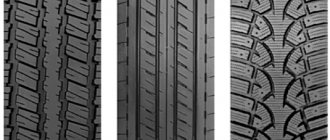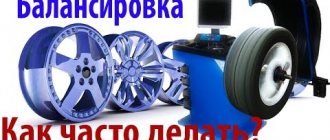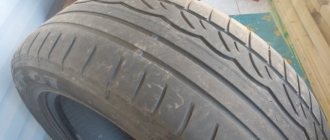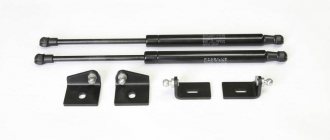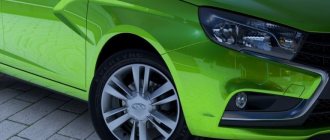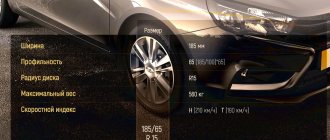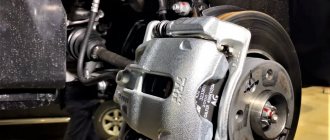What should be the tire pressure of Lada Vesta
| Tire size with load capacity and speed indexes* | Wheel size | pressure in tires front/rear, MPa (kgf/cm2) |
| rim width (inches) | partial load*** | |
| 185/65R15 88T, H 195/55R16 87, 91T, H | 5J, 5½J, 6J 5½J, 6J | 0,21/0,21 (2,1/2,1) |
3 lines•
What tire sizes does the manufacturer recommend to install?
The designers of the AvtoVAZ automobile plant made every effort when developing the project to create a modern appearance. Alloy wheels equipped with fairly wide tires are installed at the factory.
Standard wheel parameters for this model:
- bolt pattern – 4×100 (4 holes for studs with a distance between them of 100 mm);
- diameter of the mounting hole – 60.1 mm;
- tire diameter - 15 or 17 inches (different tires are installed on cars equipped with different engines);
- The rim width also varies on different versions of the car - 6J, 6.5J, 7J.
It is important to note: the body geometry on cars equipped with excellent engines also varies. Therefore, not just any tire will do. The full list of recommended tires includes 6 items:
- wheel width – from 185 mm;
- tread height – from 45 mm;
- wheel diameter - from 15 inches.
Moreover, there is an inverse proportional relationship between the width of the wheel and the height of the profile. The larger the first parameter, the smaller the second should be. For example, 185/65 tires are installed on wheels with a diameter of 15 inches. For wheels with a diameter of 17 inches - 215/45. Speed and load indices for a given car also vary, depending on the configuration.
Changes range from 86S to 92H. Curb weight can be approximately 530-630 kg. The maximum permissible speed is from 180 to 210 km/h. When replacing tires on a scheduled or seasonal basis, it is better for the driver to adhere to the parameters listed above. This will avoid problems with controllability and wear resistance of mechanisms. There is a certain relationship between tire size and body type:
- sedan: 185/65 R15 88H and 195/55 R16 91H;
- station wagon: 185/65 R15 88H and 195/55 R16 91H;
- cross: 205/50 R17 89V and 205/50 R17 93W;
- sport: 205/50 R17 (93/89, W/V).
The diameter of the tires installed primarily depends on the body type. As you can see, tires with dimensions R15, R16 are mounted on the station wagon. Modifications of the same year of production, Cross and Sport, boast 17-inch wheels.
It should be noted: the diameter of the hub and the circumference of the mounting holes are identical. However, rim width and offset vary slightly for the wheels indicated above.
Vesta sedan tire pressure
The sedan version is supplied to the market with P15 or P16 wheels. The optimal pressure inside the tires is the same as for a station wagon. The only exception is recommendations from car owners.
For unpaved roads or bumpy asphalt sections, users are of the opinion that when the indicator decreases by 0.2 At, the vehicle behaves more comfortably - the sensitivity of the suspension improves, and bumps are felt less. If the buyer actively drives the car. On the contrary, it is recommended to increase the nominal thresholds by 0.2-0.3 Bar. This is argued by reducing the likelihood of puncture or damage to the wheel rims. Also, tight tires grip hard surfaces better and improve rolling performance.
Installing larger diameter discs
Large rims not only change the appearance of the car, but also affect its dynamics, maneuverability, and stability on the highway, and not always for the better.
When deciding on their installation, you should know the basic principle - the larger the diameter of the disk, the lower the height of the tire profile, because the size of the outer diameter of the wheel is tied to the size of the wheel arch - when turning, the tire should not touch or rest against anything at all steering wheel rotation range.
Testing the Lada Vesta over the course of a year showed acceptable wheel size options:
17-inch wheels were installed on the Concept version of the Lada Vesta. Technically, this sedan can also be equipped with R18 wheels, but the outer diameter of this wheel (669 mm), as well as the tire width (235 mm), differ significantly from the factory values and cannot be considered in the real conditions of Russian roads due to the too low profile as practical - defects in the road surface will quickly damage both tires and wheels, the price of which, due to their size, is several times higher than the cost of standard ones.
The effect of large-diameter wheels and low-profile tires on a car
- increasing the style of the car and the effectiveness of the exterior;
- improvement of driving qualities - dynamics, road stability, steering sensitivity;
- better “absorption” of potholes compared to a smaller radius;
- with a tire profile from 55 – increased durability of the suspension;
- reducing the braking distance;
- increasing the efficiency of ABS and ESP.
- uncomfortable driving due to sensitivity to road surface defects;
- restriction of use on roads with defective surfaces;
- the need for increased pressure control;
- greater need for kinetic energy at the start - higher fuel consumption;
- higher cost.
Low profile tire pressure
This parameter, ignored by novice car enthusiasts, is very important when operating cars with any tires, and especially with low-profile ones. The required tire pressure is always indicated by the vehicle manufacturer in the operating instructions and in an accessible place on the body, for the Lada Vesta - on the B pillar on the driver's side.
Day one: pre-launch swamp
Damn it! What kind of swamp is this?!
Our technical specialist Valery Zharinov is beside himself. It’s an hour and a half before the start, and the Focus’s interior smells of damp, and there’s ankle-deep water on the mats!
One of the mannequins, apparently, was so frightened by the upcoming severe tests that, sorry, he peed himself - the bottom plug couldn’t stand it.
We had to quickly bail out the water from the car and replace the “coward” with three bags of ballast, 25 kg each.
As soon as the flooding was eliminated, a new problem arose: an error in the tire pressure sensor was displayed on the Creta’s instrument panel. We checked the tires - they are normal. The pictogram was on until the finish line, but none of the tires showed signs of losing pressure. We console ourselves with the fact that these sensors are faulty in many cars.
In the pre-dawn darkness, the cars took to the cobblestone road, on which we maintain an average speed of 35 km/h.
You have to be especially careful when driving the Focus - it has the most modest ground clearance. In terms of energy intensity, there are zero complaints against Ford. It swallows bumps and potholes of any size without difficulty. Even the rear shock absorbers, which bore the greatest load (taking into account “passengers” and ballast), heated up to a maximum of 60 °C, which is not much. But if you miss a big bump or the swaying body goes into resonance, you will quickly catch the blow.
Creta also confidently avoids the pitfalls of “cobblestones”; the “parquet” ground clearance of 170 mm adds optimism. And Lada is no slouch: even a regular SW station wagon has almost 180 mm under engine protection, and the SW Cross is even higher - 200 mm.
But - amazing thing! — on a road replete with transverse waves, be it a cobblestone ring or a dirt road, we liked the regular Vesta SW better! The Cross has a higher center of gravity and the characteristics of the shock absorbers have been changed, so the body sways more. Low profile tires force you to be alert and transmit more small vibrations to the body. Within two hours, a hernia appeared on the cobblestones on the left front wheel.
The SW Cross also suffered from a minor malfunction - the rear left light bulb burned out.
As soon as it got light outside, we started braking on the highway. Acceleration to 130 km/h - and braking to a complete stop. In order to avoid scattering of the braking distance and intensity of deceleration caused by the change of tester, two cones were placed in each braking zone - 75 and 85 meters from the start of braking. Each time we had to stop in this ten-meter corridor.
The Focus turned out to be the most stable when braking. Creta and both Vestas require slight course correction on uneven and wet asphalt. And in terms of efficiency and ease of deceleration, all cars are at their best.
In this rhythm, Ford showed the best performance, consuming slightly less than 12 liters per hundred. The Creta was a liter more wasteful. And the Ladas turned out to be the most voracious: almost 14 l/100 km. Their consumption coincided up to a tenth of a liter, which to a certain extent indicates the stability of quality.
We ended the first day with what we started with - “boulder”. At the end of the day, one of the test drivers did not notice a protruding stone and bent the front left disc on Vesta SW. Our mobile tire service arrived promptly, and ten minutes later the “convoy” of four cars continued its journey.
How often to measure to kill rubber
Please note that pressure may change due to changes in ambient temperature. Moreover, the process occurs equally in winter and summer.
The main rule when checking is to measure it before driving, before the tires get hot. After a short trip, the wheels become very hot and the performance differs significantly from the real ones.
Measurements should be taken not only after tire wear has become noticeable. The manufacturer recommends checking the inflation when you feel that the car is behaving differently. For example, it began to throw to the sides, uncertainly when entering turns. In any operating book you will find information that a check must be carried out if temperature changes reach 10-15 degrees. As a rule, these are the spring/autumn seasons, be careful this is a time of temperature fluctuations.
Vesta tire pressure in winter and summer
During seasons of critical ambient temperatures, it is necessary to check the pressure inside the tires at least 3 times a month.
This is argued by the fact that when the temperature increases or decreases, the air changes volume. For example, a situation is simulated: a car is moving at +40 °C on a highway. At the same time, under the influence of heat and friction, the tires heat up, and the compression of the air inside increases. Thus, diagnostics must be performed every 350-400 km, and the indicators must be equalized to the standard values (usually fluctuations are no more than 0.3 BAR).
In winter, on the contrary, the temperature drops, the on-board panel may display the following sign:
This is normal TPMS processing. With this icon, the car says that you need to pump up the tires to the specified level. Usually the difference with the standard is no more than 0.3 At.
How often to measure to kill rubber
Please note that pressure may change due to changes in ambient temperature.
Moreover, the process occurs equally in winter and summer. The main rule when checking is that you should measure it before the trip, before the tires heat up. After a short trip, the wheels become very hot and the performance differs significantly from the real ones.
Measurements should be taken not only after tire wear has become noticeable. The manufacturer recommends checking the inflation when you feel that the car is behaving differently. For example, it began to throw to the sides, uncertainly when entering turns. In any operating book you will find information that a check must be carried out if temperature changes reach 10-15 degrees. As a rule, these are the spring/autumn seasons, be careful this is a time of temperature fluctuations.
Choosing winter wheels for Lada Vesta SW Cross: comparing sizes and prices
Video review of the Lada Vesta Cross station wagon from AvtoVAZ
The standard characteristics of the wheels, which are produced at AvtoVAZ and come with the Vesta, are very similar to the sizes of other Lada cars. However, installing them is not recommended.
Standard parameters of disks 185/65/R15 88 N. Explanation:
- Wheel width – 185 mm;
- Wheel profile – 120.25mm;
- Disc radius – 15;
- 88 is a number indicating the carrying capacity, which is equal to 560 kg;
- Speed index – H (210 km/h)
These characteristics are installed on the standard equipment of the car.
Despite the fact that many people are not satisfied with the wheel design, it is very practical and does not catch the eye. The choice of such discs is not a decision of one person, but of a team of specialists. The model is presented in a neutral form without a complex structure. The wheels do not stand out from the crowd of cars. Standard wheels on Lada Vesta Cross have the following characteristics:
- Radius R17;
- Drilling 4×100;
- The diameter of the central hole is 60.10;
- Fasteners (Bolt 12*1.5);
- Disc width 6.5J x 17;
- Departure ET41;
Orange “Mars”, a plastic body kit along the lower contour and 17-piece wheels – everything is beautiful and practical. As it turns out, up to a certain point. When you need winter tires for Vesta SV Cross, discussions about the attractiveness of standard “skating rinks” fade into the background. In addition, doubts arise about the ability of low-profile tires to “digest” a packed, bumpy road without critical consequences.
What is the problem
The main reason for the agony of choice is the high cost of tires in their native size 205/50 R17: this is evidenced by reviews of the Lada Vesta SW Cross. Let's take, for example, the Finnish new Nokian Hakkapeliitta 9. In the factory standard size, one “cylinder” costs about 11,000 rubles. The average price of the same spike in size R15 is 5,500 rubles. Double savings.
The gain in the initial price is complemented by another plus: the second set of wheels allows you not to go to the tire shop every season. Changing the shoes twice and balancing the 17th wheels will cost 3,000 rubles, which is not cheap. The third aspect is the smoothness of the ride: it is noticeably higher with decreasing rim diameter. With all these positive aspects, R15 tires look great in the arches of the Cross Vesta. Another thing is ground clearance... But here, too, catastrophic losses can be avoided.
However, owners of new cars prefer to partially deviate from these recommendations and use products of other sizes. Let's compare the performance data of various tires and enter them into the table.
| Standard size | Outer diameter, mm | Difference with standard diameter, mm |
| 205/50 R17 | 637 | – |
| 195/65 R15 | 635 | -2 |
| 185/65 R15 | 622 | -15 |
| 205/55 R16 | 632 | -5 |
We get two optimal sizes: 15th (195/65) and 16th (205/55). These wheels only slightly reduce the main advantage of the Cross: 203 mm ground clearance. 185/65 R15 significantly reduces ground clearance - by as much as 7.5 mm.
Replacing disks
When switching to 15-gauge tires of a non-standard format, you will have to select car wheels using a calculator. However, the light alloy version for the 195/65 R15 tire has long been studied by Vestavod:
- Bolt pattern – 4x100.
- Reach – 43-45 mm.
- Width – 6J.
- The central hole is 60.1 mm.
Owners of Vesta SV Cross need to make a decision about choosing winter tires of a different size consciously. The instruction manual allows only 205/50 R17 to be used in this version. Installing a different standard size may cause contradictions of the following nature:
- Loss of warranty (maybe not - discussed with the official dealer).
- Refusal of insurance payments in accordance with current legislation.
- Inability to register a vehicle because changes have been made to the design of the vehicle.
